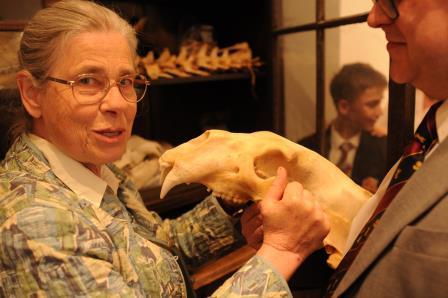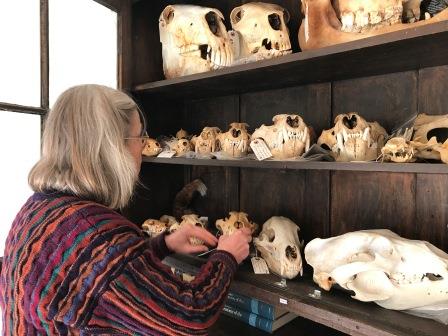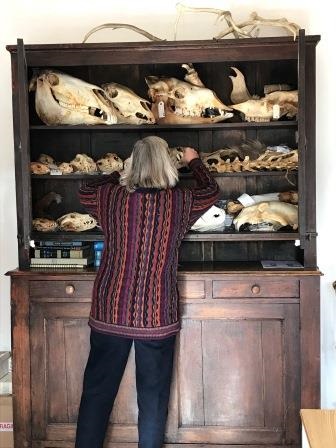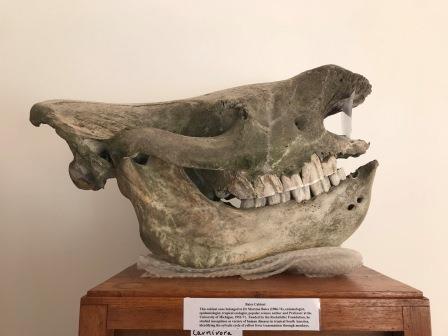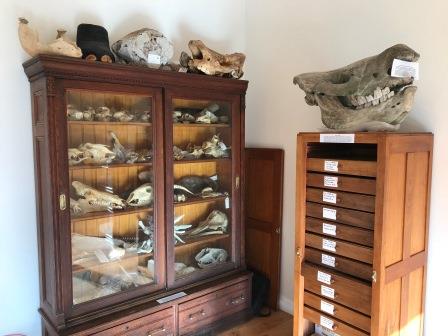News
The Pond Collection at WildCRU – an interview with Dr Caroline Pond
The Pond Collection at WildCRU headquarters in Tubney is a wonderful zoological asset. Donated by Dr Caroline Pond, the Collection is a by-product of four decades of her research in comparative anatomy and physiology, specifically into the functional interpretation of the anatomical organisation of vertebrate adipose tissue (fats) and natural obesity. With skeletons, skins and other fragments from over 400 animals, the Collection is housed in beautifully converted garages, formerly stables, behind Tubney House.
Dr Pond read Zoology at Oxford, and supported by a Christopher Welch Scholarship, completed her DPhil on insect flight in 1971 under the supervision of Professor J.W.S. Pringle FRS. She then served four years as Departmental Demonstrator in physiology, and after periods in USA, Caroline returned to Britain in 1979 to work for The Open University in Milton Keynes until she retired as Professor of Comparative Anatomy in 2010.
A combination of Oxford’s 1960s Zoology curriculum plus periods spent teaching veterinary anatomy convinced Caroline that the study of adipose tissues (often the most abundant tissues in cadavers) was sorely neglected. Thus she decided to explore vertebrate adipose tissue, seeking functional and phylogenetic explanations of its distribution and controls in natural obesity. Whilst using lab rodents produced some useful information, Caroline was aware that some animals in the wild became naturally both fatter and thinner than would be technically possible (or legal) to induce in lab animals. Believing that such extremes would reveal the anatomy more clearly, she began collecting road-kills, culled vermin and other ‘junk’ wild animals for a parallel comparative study.
The rapid expansion of Milton Keynes from the 1970s, with many new housing estates, roads, and, yes, roundabouts, proved an exceptionally rich source with many wild animals killed in road accidents. She recalls working with a network of informers – lorry, truck, bus drivers – who notified her of road-kill sightings: “I’d have to drop everything to collect them as quickly as possible. Many of these specimens began their posthumous careers on the back of my bicycle. There were some pretty hairy occasions! But I suppose I collected more than 500 animals altogether.”
“Dissection and collecting samples of adipose tissue were done in the lab, but cleaning and preparing the skeletons became a weekend and evening operation that was largely conducted in the garden and garage of a suburban semi in Milton Keynes – not what you’d expect!”
The Pond Collection includes material from birds, reptiles, amphibians and fish, but the majority are mammals. In pride of place is the almost intact skull and jaw of a northern white rhino, which is now almost extinct, though the species was widespread when Dr Peggy Varley, who taught in Zoology 1962-9, collected it from southern Uganda in 1950. Other specimens range from the tympanic bulla (ear capsule) of a fin whale, one of the densest bones known, down to the fragile skull and jaw of a neonatal lion, African elephant molars and fragments of narwhal tusk.
Housed in antique oak, walnut and cherry display cabinets, each specimen has been painstakingly labelled, bagged and catalogued, with comprehensive information about each specimen’s components.
“The thing is, I remember each of them, how I acquired it, what information was obtained.” laments Dr Pond whilst showing the beautifully arranged skeleton of an African Grey parrot. Although claiming to not have a favourite item in the Collection, there is a fondness for this one: “Someone gave me the cadaver so I prepared it – spine, keel bone, legs, wings, neck, skull… each limb neatly labelled and put in this box.”
Professor David Macdonald, founding Director of WildCRU, who has been friends with Caroline since she survived the attempt to teach him insect neurophysiology as an undergraduate, said “We are delighted and honoured to have the Pond Collection at WildCRU, the specimens will inspire and inform, and the marvellous new space in which they are housed will become a focal point for our staff and students to enjoy conversation, concentration and contemplation in a setting at the intersection of fundamental zoology and conservation futures. Caroline Pond has done a great thing in bringing us this collection and in creating the space to house it, and we applaud and thank her.”
The Collection at WildCRU is not a museum, it is a research resource available to all scientists. Approved users may remove items to take samples for any biologically-relevant purpose. Much of the material comes from naturally obese wild animals whose genes may reveal how they manage appetite, thermogenesis, exercise and energy storage so efficiently while modern people develop obesity-related diseases. For the Catalogue and information about access and use, please visit the website page here.






